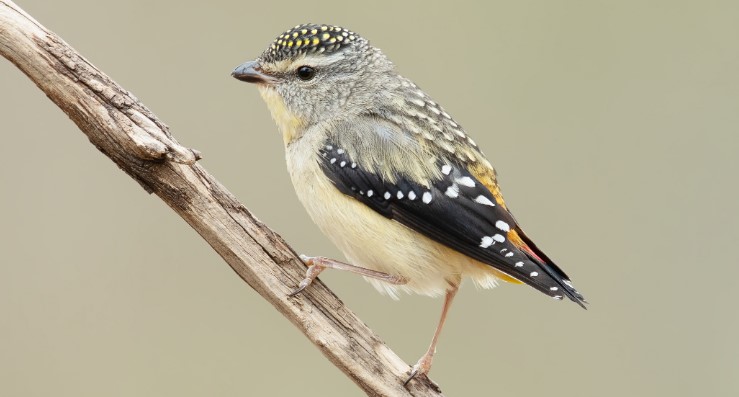Well, the extinction may be facing the Forty-spotted Pardalote (Pardalotus quadragintus), which is found only in Tasmania. It is also named Tasmanian Diamond Bird and Many Spotted Pardalote. The size of the Forty-spotted Pardalote is about 95-100 mm in length. The numbers are decreasing that is already low probably not more than 1000 individuals scattered between 6 or 7 relict populations on islands and peninsulas in the southeast and east of Tasmania and in the Bass Strait.
From 1838, when naturalist John Gould first described it, until the 1920s, it had a much wider distribution in Tasmania. There has been a dramatic decline in its numbers and contraction of its range since then; the only colonies that appear to be alive are on Bruny Island and Maria Island.
Reasons for the overall decline are complex but may reduce to two central issues: quality of habitat and competition from other pardalotes. Regardless of where they live today, Forty-spotted Pardalotes live in sedentary colonies in mature mixed eucalypt forests with hollow trees, fallen logs, and stumps to use as nest sites. Manna gums and Eucalyptus viminalis are dominant. These forests have been pushed back by widespread clearing. With short, rounded wings, they are not strong fliers like other pardalotes.
Read More: Striated Pardalote – One of the Largest of the Small Pardalotes

Each pair returns to the same hollow or a nearby one each year even after breeding and disperses little out of breeding season. Change is not readily accepted by them, according to experiments. Their main competition comes not from the more closely related but smaller Spotted Pardalote but from the larger Striated Pardalote. Forty-spotted forage in the same way for the same food in the same trees as Striateds, working methodically through the higher outer foliage in mixed forest and hanging on twigs-even more so as they glean lerps and manna from eucalypt leaves. They also nest in tree hollows and stumps.
Straying Forty-spotted are chased off by Striated Pardalotes and honeyeaters and cannot maintain themselves outside large colonies; even their broods may be lost because adults spend so much time in defense. So the chances of establishing new colonies and expanding under present ‘natural’ conditions are slim. Forty-spotted Pardalotes feed regularly in eucalypt crowns, usually more than 10 meters above the ground.
As well as worms and manna, they pick up a range of small spiders and insects: beetles, wasps, flies, weevils, leaf bugs, millipedes, and termites. Compared to other pardalotes, they work more slowly. Although some birds-probably young of the year-do wander locally during autumn and winter, most birds are so set in their feeding pattern-foraging on a regular beat through just two or three trees-that they can be found almost in the same pocket of foliage year round.
It is common to see groups of up to 10 or more fluttering through the trees in winter, calling spiritedly, fluttering their wings, and posturing. There are no more than 10 meters between the nests of Forty-spotted Pardalotes, which occur in colonies. It appears that most pairs mate permanently, keeping their bonds throughout the winter and returning to the same nest sites. The female probably builds the nest and both adults incubate the eggs and feed the young. Because of the long fledging-time of apparently 25 days, only one brood may be reared a year.
Read More: Spotted Pardalote (Pardalotus punctatus)
Both sexes are similar. The upper parts are dull olive-green faintly scalloped with black; the upper tail coverts yellow-green scalloped with black. The tail is black with a white tip. Wings and wing coverts are black, feathers tipped white. Face and undertail coverts lemon-yellow; throat pale grey with yellow tinge; breast pale yellow-grey with darker grey mottling; belly buff-grey. Their eyes are dark brown. Bill is short, stubby, notched, and black. Feet are fawn-pink with a purple tinge. The immature bird is similar to adults; face and undertail coverts are duller yellow.
The Forty-spotted Pardalote has a normal call a repeated, soft, nasal whi-whi or whi-oot, with stress on the first syllable. In the breeding season, the male has a loud, nasal territorial call twint. Both sexes utter soft whi contact call at the nest. Nesting and breeding season occurs in September-January.
Nest dome-shaped or cup-shaped, depending on the size of the nest cavity, made of fiber from stringy bark, lined with fine Poa grass, wool, and feathers; placed in hollow branch or tree trunk up to 20 m from the ground or, occasionally, in a hole in the ground.
Forty-spotted Pardalote lays 3 to 5 eggs, which are lustrous white; oval in shape, about the size of 17 x 13 mm. The incubation period is about 15-16 days, for both sexes. Young fledge in 25-26 days.
Forty-spotted Pardalote total population, perhaps not more than 1000 individuals, in colonies in the southeast and islands off the coast there. Found only in sclerophyll forests, with a preference for white gum Eucalyptus viminalis as a food tree. It is likely extinct on King and Flinders Islands. No races.
Read More: Red-browed Pardalote (Pardalotus rubricatus)







